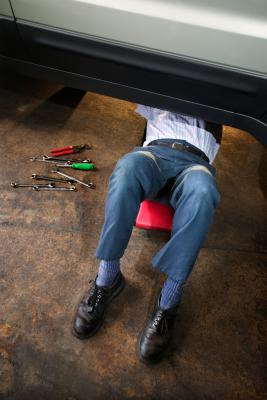
Input shaft bearings allow for the smooth rotation of the transmission input shaft. Transmission input shafts extend out of the transmission toward the engine. Replacing the bearing itself is easy. However, the transmission must be removed to access the bearing, which, for safety reasons, is a two-person job. The difficulty of lowering and reinstalling a transmission depends on its size, whether it is automatic or manual, and whether any exhaust components, such as catalytic converters, run underneath the transmission.
Jack up the vehicle on a frame section behind each front wheel, one side at a time. Make sure you raise the vehicle far enough to have access to work around the transmission. Place a jack stand under each side, under a frame section close to the jack. Carefully lower the vehicle onto the jack stands.
Place a drain pan under the rear of the transmission, where the drive shaft yoke connects to the transmission output shaft, to catch any leaking fluid. With a wrench, unbolt the drive shaft from the transmission and swing it to the side.
Disconnect any attachments on the transmission. Different connections are found on the transmission, including cooling lines, cables and wiring plugs. Pull off the electrical connections, use a wrench to disconnect the cooling lines, and remove the speedometer and throttle valve cable (if present) by loosening their retaining bolts and pulling them out.
Remove the inspection plate, if removing an automatic transmission. It's located forward, under the transmission. Use a socket wrench and socket to loosen the plate's bolts and remove it, allowing you access to the torque converter
Use a wrench to unbolt the automatic torque converter through the inspection plate opening. Only one bolt is accessible at a time, requiring your helper to manually crank the engine over by placing the appropriate deep socket on the crankshaft pulley bolt, located at the front of the engine, in the center of the pulley. As he turns the engine, each bolt, one at a time, becomes accessible.
Unbolt the starter and the transmission using a socket wrench, extension and socket. Remove the starter. Remove the bolts connecting the bell housing to the engine.
Unbolt the manual shifter linkage. If you're removing a manual transmission, the linkage is normally on the driver's side of the transmission, and is removed using a wrench. The shifter linkage changes gears as the vehicle is manually shifted. Remembering the linkage setup makes reassembly easier.
Place the transmission jack under the transmission, forward of the cross member holding the transmission in place. Jack it up until it begins to lift the transmission, then connect the chains or straps, holding the transmission in place on the jack. When the jack is in place, remove the cross member by unbolting it using a socket wrench and socket.
Loosen the transmission from the engine by working it outward and side to side with a helper. You may have to raise the jack during this process. The transmission eventually works its way out, exposing the input shaft.
View the inside of the bell housing, where the input shaft is centered. Remove the bolts surrounding the input shaft retainer and slide it off. The bearing seal is now visible. Remove the input shaft bearing seal with a screwdriver. Throw the seal away.
Slide out any shims. Shims are circular spacers between the seal and the bearing. Slide them out and keep them in order. Remove the input shaft bearing and, by hand, pack the new bearing with grease, making sure the inner bearing is greased thoroughly. Grease the outside of the bearing as well. When finished, insert the new bearing, shims and the bearing seal. Gently tap the seal to set it in place.
Reinstall the transmission by reversing the removal process. Be sure to reconnect the shifter linkage on manual transmissions and replace any lines, connections and cables back on the transmission.